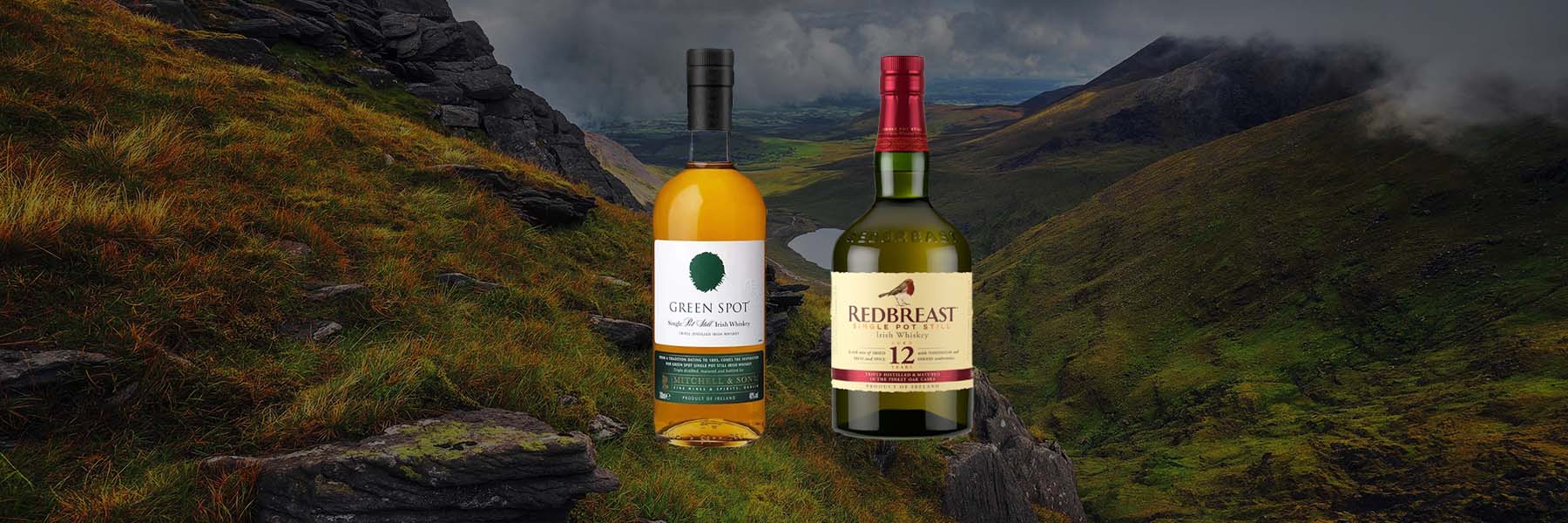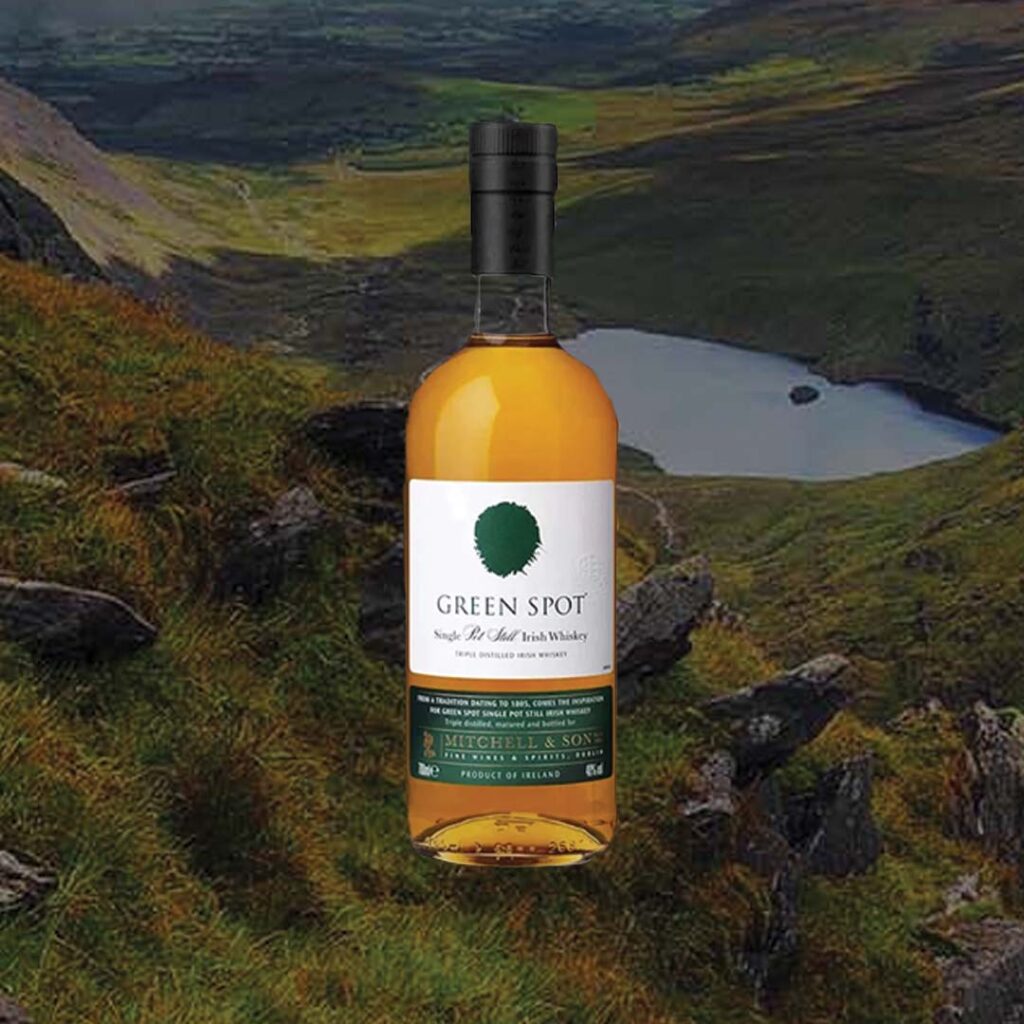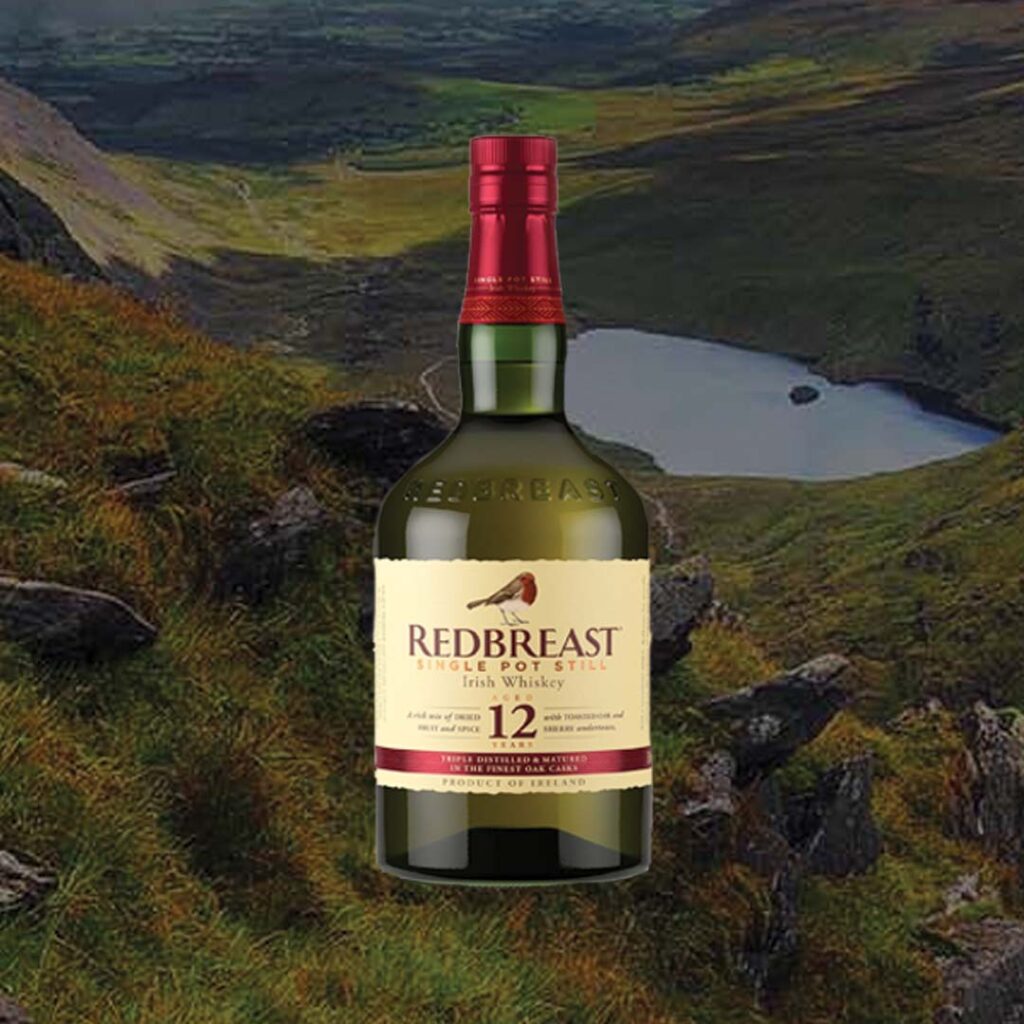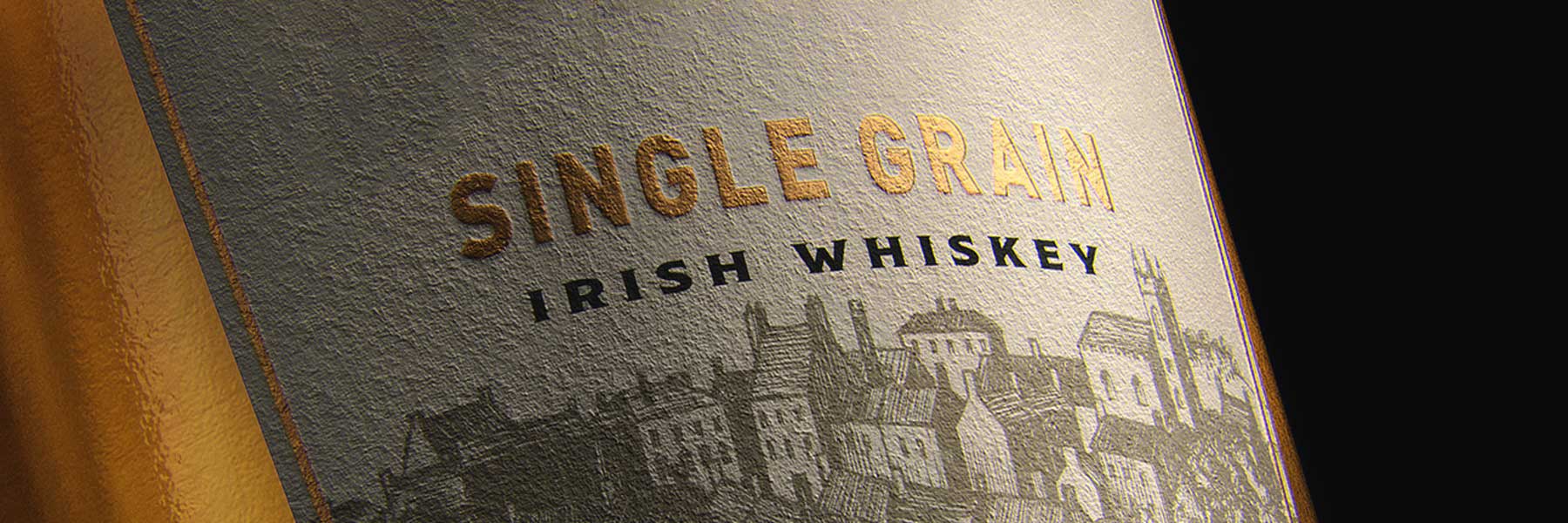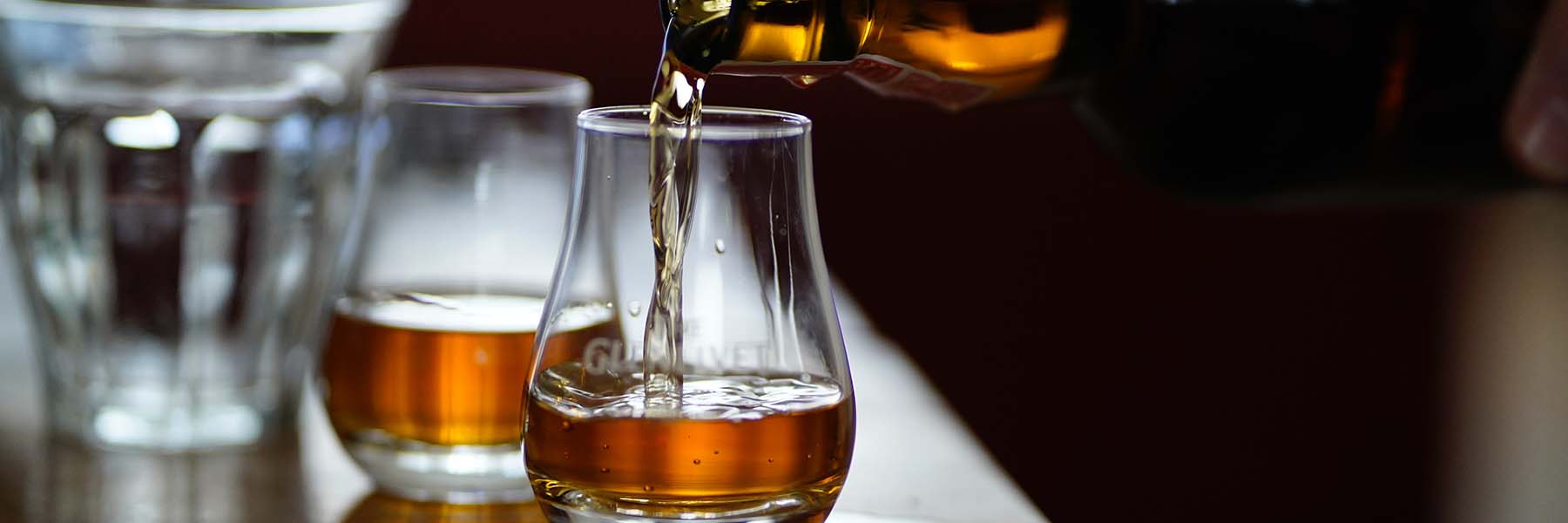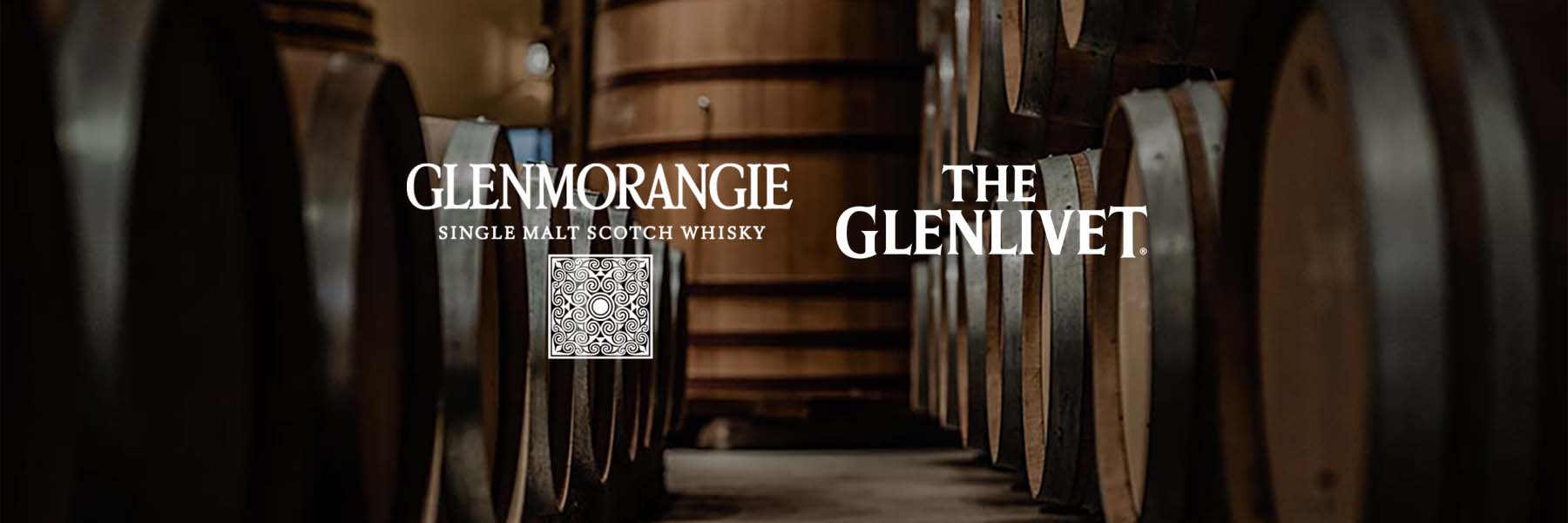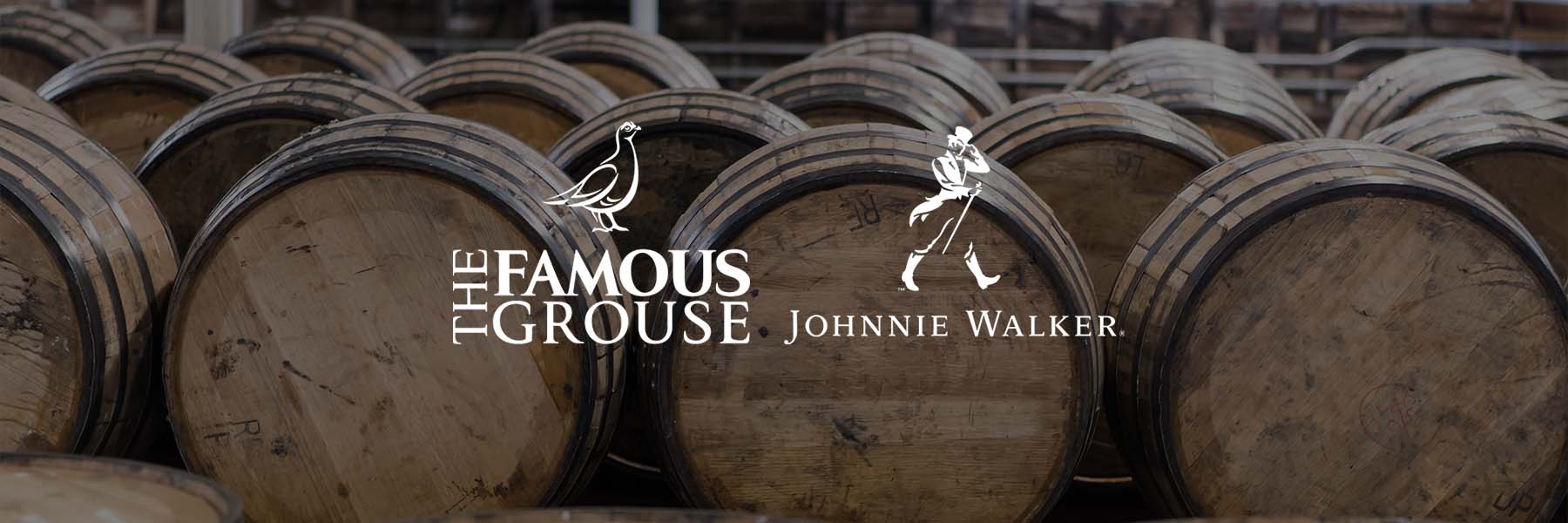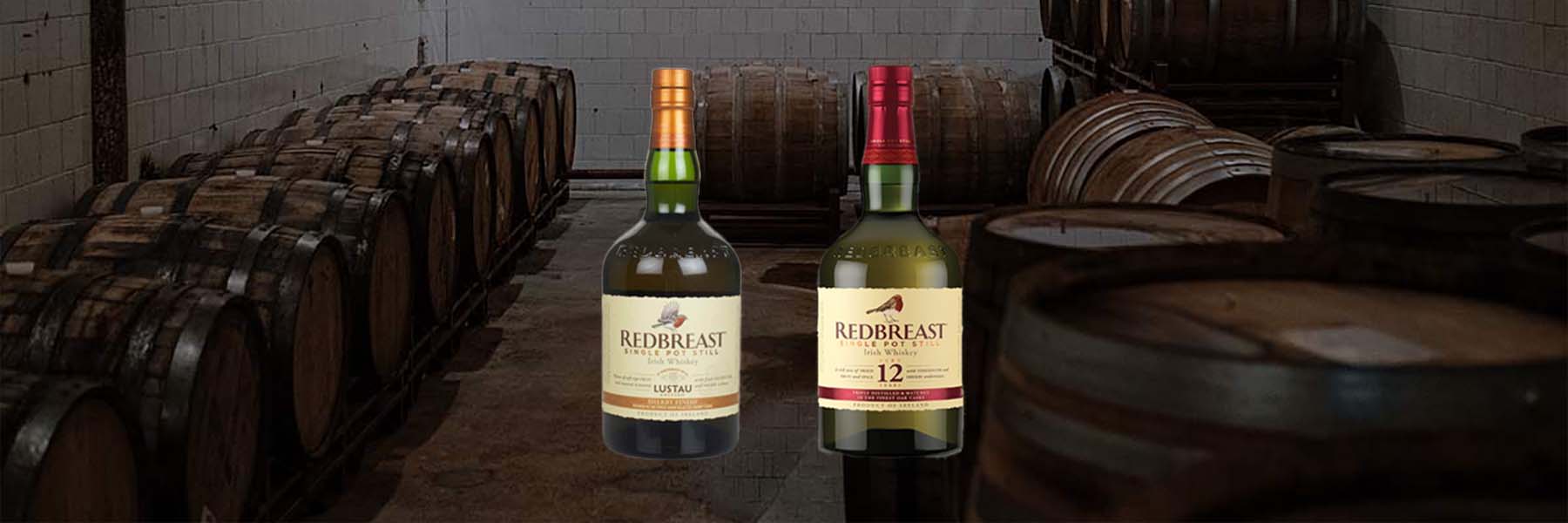Green Spot vs Redbreast 12: A Tale of Two Irish Titans
Green Spot vs. Redbreast 12 is much like a journey to Ireland—not physically, though, but a personal review taste of two widely admired Irish whiskeys.
These two spirits have garnered respect and popularity among whiskey enthusiasts globally, and it’s time to dig deeper into why.
Let’s talk about Green Spot first; a whiskey originally hailing from Mitchell & Son in Dublin. If you haven’t tried it before, imagine a playful, fruity, and slightly spicy taste that lingers in your mouth. It’s one of those whiskeys that stick with you, and not just because of the flavour.
The first time I tried Green Spot, I was taken aback by its full-bodied, rich character, its hints of orchard fruits and the slightly peppery finish. It was like a bright Irish afternoon encapsulated in a glass, a flavoursome reflection of its Dublin roots.
The story behind Green Spot is equally engaging. Mitchell & Son started as a wine merchant in the 1800s, storing and maturing whiskey in their cellar. They marked their whiskey casks with different coloured splodges of paint to indicate their age, hence their name of Spot Whiskeys. Interestingly, the 10-year-old barrels marked with a green spot stood out for their exceptional quality, thus the name Green Spot.
Now, let’s hop South to County Cork, where the enormous Midleton Distillery produces Redbreast 12 (along with Jameson, Powers, Spot Whiskeys and more!). One sip of this and you get this robust explosion of flavours—notes of toasty oak, ripe fruits, and a dash of spice. It’s a melody of tastes that warms you up from the inside. I remember the first time I tasted Redbreast 12, I was instantly drawn to its smooth and complex character, as well as its alluring aroma of nutty, rich flavours.
Redbreast 12’s history is as rich as its flavour. The whiskey continues a tradition dating back to the early 20th century, first created by Gilbey, a wine merchant like Mitchell & Son. What stands out about Redbreast 12 is that it continued production even during the Irish whiskey industry’s most challenging times. That’s Irish perseverance for you…in a bottle.
Both these whiskeys offer unique flavour profiles and are steeped in rich histories. They’re not just spirits in a bottle; they’re representations of Irish craftsmanship and storytelling.
Quick facts
- Both are single pot still Irish whiskeys.
- Both whiskeys are made at the Midleton distillery in County Cork, Ireland.
- Both whiskeys are triple distilled using traditional copper pot stills.
- Both whiskeys are made from malted and unmalted barley.
- Spot Whiskeys are one of the few remaining bonded Irish whiskeys.
Green Spot vs Redbreast 12
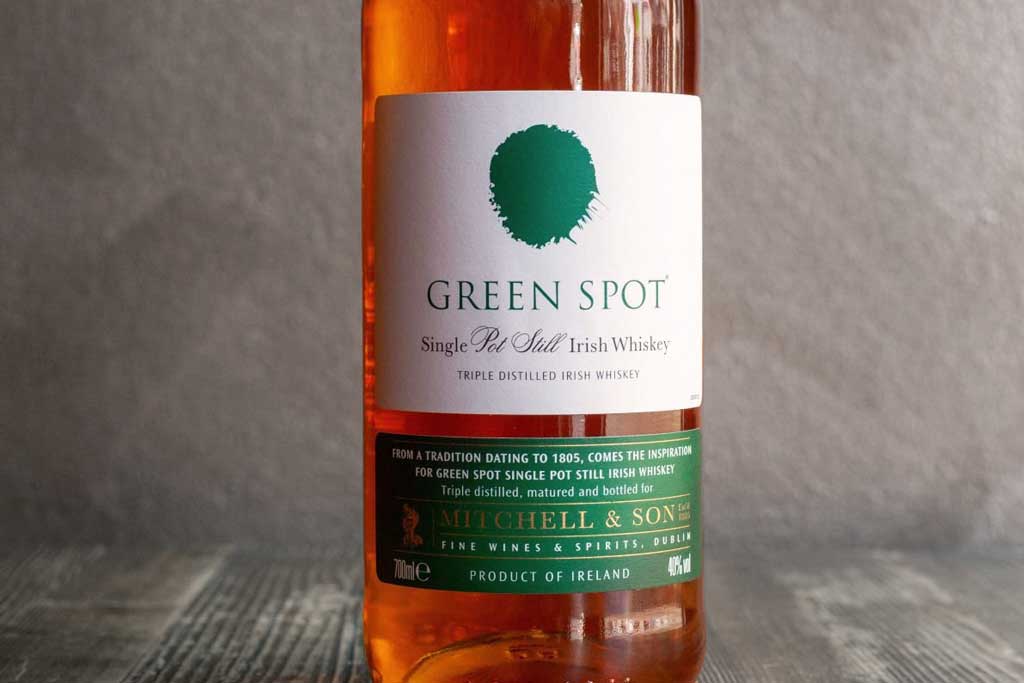
Green Spot Review
On the nose, you immediately get a sense of fresh aromatic oils and spices with orchard fruits and barley on a background of toasted wood. It’s clean and sweet, like a breath of fresh air.
The mouthfeel is wonderfully smooth on the palate, and even though it feels thick, it’s not cloying or overly oily. It’s just the right balance to give you a robust taste without feeling too heavy in your mouth.
On the palate, Green Spot doesn’t disappoint. You’ll find a pot still spiciness coming from the traditional use of unmalted barley. With some patience, brighter notes come through, tasting of red apples, nuts, and citrus fruits all woven together with vanilla and a hint of honey. It’s like a symphony where every note hits at the right moment, creating a harmonious blend that dances on your tongue.
The finish is long and flavoursome. I get a lingering sweetness with spices, wood, and barley making their appearance one last time as the taste eventually fades.
Are there any whiskeys it can be compared to? You bet. I liken it to Jameson 12-year-old whiskey because of the similar aromatic oils and spices.
Pros & cons. On the upside, it offers a unique blend of flavours and a smooth mouthfeel that will appeal to many. However, for those seeking a stronger, more robust flavour, it might fall a bit short. That’s my honest take on it.
At 40% ABV, Green Spot whiskey stands at the minimum required strength for single pot still Irish whiskey. As expected, it’s not overpowering in any way and I personally didn’t feel the need to add any water. But, it’s not too weak that you’re left wanting for more either. It’s just right.
Is it worth the money? At £43 / $55 a bottle, several factors come into play. This is a NAS (no age statement whiskey) with an estimated age of between 7-10 years. Compared to the 12 year old Redbreast is a younger, less mature bottle. However, considering the (still long) maturation process, the quality of ingredients used, and the traditional distillation method all contribute to its cost. When you taste Green Spot, you’ll understand where every penny went. For a single pot still Irish whiskey of this calibre, personally, I think it’s a good investment.
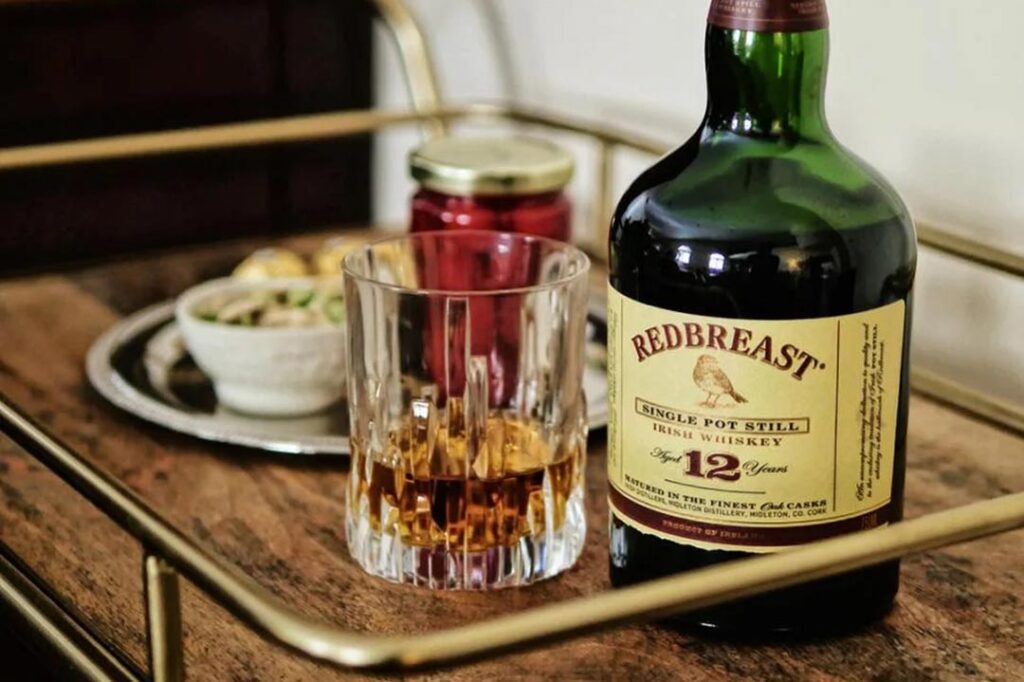
Redbreast 12 Review
On the nose, Redbreast 12 is nothing short of delightful. Taking a deep breath in, I get nutty notes, mixed with rich fruit, and a hint of marzipan. Presumably coming from the unmalted barley are subtle wafts of warm baking spices. It’s a delightful bouquet that I find incredibly inviting.
The mouthfeel is super creamy, almost buttery. On my first sip, it slides smoothly, coating my mouth with its velvety texture. The triple distillation makes this whisky exceptionally easy on the palate, whilst having the expectedly thick texture from this trip pot till distillate.
The flavour is robust and full-bodied, yet impeccably balanced. I find that it starts sweet, with flavours of fruit and nuts, then evolves into a spicy character with a hint of sherry. The complexity and harmony of its flavour are what make this whiskey stand out.
The finish is just as impressive. It’s long-lasting with the warm flavours of spices and fruit lingering. I’m left with a pleasing aftertaste that’s just begging for another sip. Comparisons? Sure, there are a couple that spring to mind. Its competitor for today, the Green Spot, is a notable one due to its similar balance and complexity.
Pros & cons. While the complexity and richness of Redbreast 12 are its strength, some may find it a bit too robust, especially if you’re new to whiskey. But let’s be clear, this is no deal-breaker. It’s just about personal preference.
At 40% ABV, Redbreast 12 is the same strength as Green Spot. Not too fiery, but not lightweight either. It’s got just the right strength to deliver its full array of flavours without being overwhelming. Again, I found this whiskey perfectly easy to drink neat, without any watee or ice.
Is it worth the money? At £47 / $52, Redbreast 12 is a slightly more expensive than Green Spot. Take note of the long aging process, the high-quality ingredients, the pot still distillation method, and, of course, the brand’s reputation for excellence. When you buy a bottle of Redbreast 12, you’re getting your money’s worth, and then some.
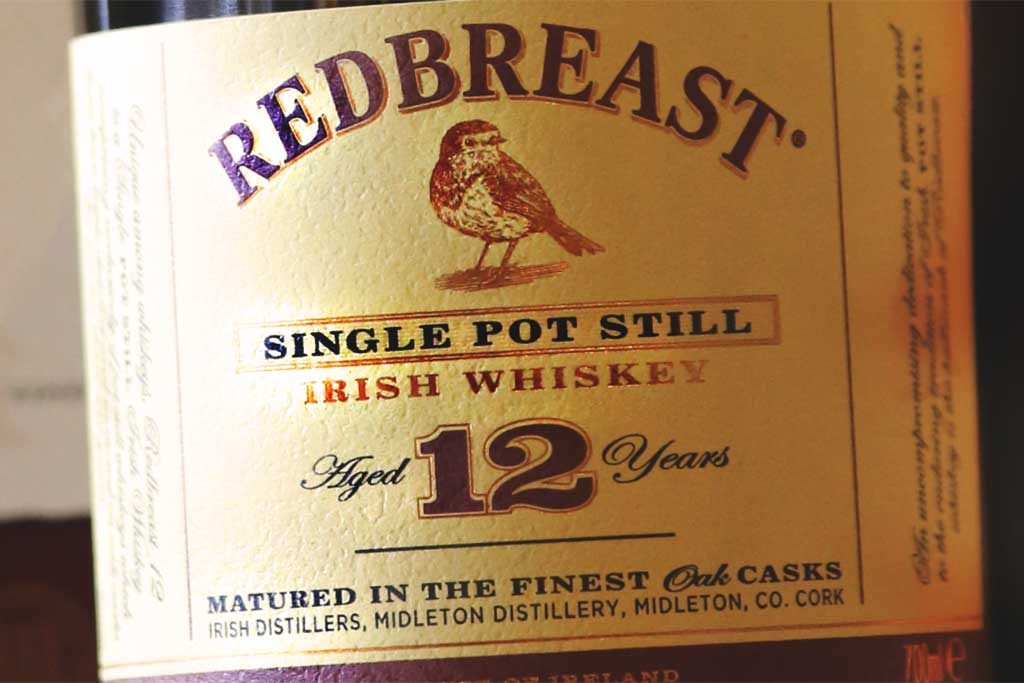
Comparing Green Spot vs Redbreast 12
Nose Comparison
Green Spot offers fresh aromatic oils and spices along with some orchard fruits and toasted wood. It’s clean, and it’s sweet. Redbreast 12, on the other hand, presents you with ripe fruit, nuts, and spices but with a sweet hint of vanilla. If you’re after a fresher, lighter aroma, Green Spot might be your pick. But if you lean towards deeper, more complex fragrances, you might prefer Redbreast 12.
Mouthfeel Comparison
Green Spot is super smooth and a bit thick, but not too heavy. It’s like a well-made latte, creamy but not cloying. Redbreast 12 is also smooth and even a bit oily, which gives the flavours an extra punch. It stays in your mouth for a while, which is great if you like to savour your whiskey. Both are comfortable on the palate, but the Redbreast 12 might edge out Green Spot if you love a longer-lasting, flavoursome mouthfeel.
Flavour Comparison
Green Spot plays a beautiful symphony of pot-still spiciness, red apples, nuts, and citrus fruits, rounded off by vanilla and a touch of honey. Redbreast 12 brings out dried fruits, toasted wood, spices, and a little marzipan. Both are complex and rich, but they offer different experiences. If you prefer a bit more spiciness and fruitiness, you might lean towards Green Spot. If you’re a fan of dried fruit flavours with a sweet, nutty twist, Redbreast 12 is calling your name.
Finish Comparison
For the finish, both whiskeys give a good show. Green Spot offers a long, sweet, and satisfying finish, while Redbreast 12 provides a long-lasting, warm, and slightly spicy finish. It’s a close call, but if you enjoy a bit more warmth in the finish, Redbreast 12 might be a better fit.
ABV Comparison
When it comes to ABV, both Green Spot and Redbreast 12 come in at 40%. This is the minimum required standard for many whiskeys and it’s just right – not too strong to overwhelm you, but not too weak to leave you wanting either. However, if you prefer it on the rocks, both work well with a little dilution from the ice, which can soften the alcohol bite and open up more subtle flavours. A splash of water is particularly with Green Spot to help reveal its lighter, more floral notes within.
Price Comparison
Finally, we have the price. Green Spot is the younger and cheaper of the two, at £43 / $70 a bottle, compared to Redbreast 12 which is priced at €47 or $73. While the difference isn’t huge, it might be a deciding factor if you’re on a budget. If you ask me, both are reasonably priced for the quality and the experience they offer.
So, which bottle’s better?
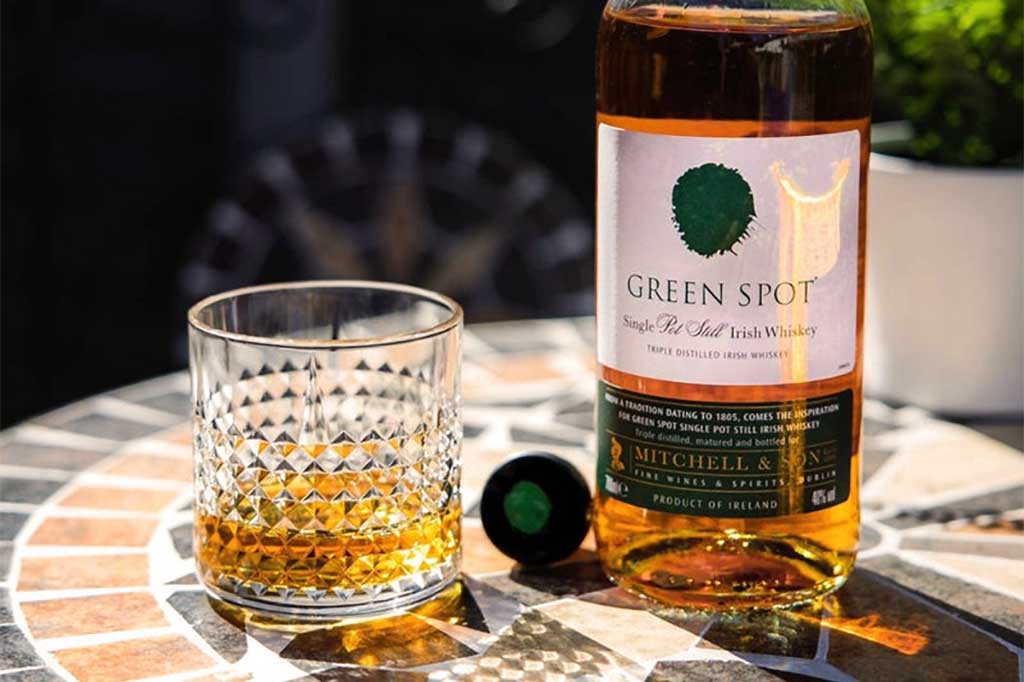
Green Spot vs Redbreast 12: Final Thoughts
To quantify my experience my experience with both these Irish whiskeys, I’ve rated each of them in the table below based on aroma, mouthfeel, taste and finish. Of curse, these rating are entirely based o my personal experience, but hopefully they help you towards making your decision on which whiskey is best for you.
| Green Spot | Redbreast 12 | |
| Colour | 5/10 | 5/10 |
| Aroma/Nose | 6/10 | 5/10 |
| Mouthfeel | 5/10 | 6/10 |
| Taste/Palate | 4/10 | 4/10 |
| Finish | 5/10 | 4/10 |
| Total | 25/50 | 24/50 |
Author’s Pick
Green Spot and Redbreast 12 both display a decent colour, the kind that doesn’t stand out but also doesn’t disappoint. However, when I put my nose to the glass, Green Spot has a slight edge. Its aroma, filled with fresh oils and spices and underpinned by the subtle whiff of orchard fruits, is a touch more engaging. It’s a welcome invitation to take that first sip.
Redbreast 12’s aroma, while decent with its ripe fruit and spices, doesn’t quite pull me in as much. It’s nice, don’t get me wrong, but it doesn’t stir my curiosity like Green Spot does.
Redbreast 12 comes back strong in the mouthfeel department. It feels a bit oilier, fuller, and lingers nicely on the palate. However, Green Spot isn’t lagging too far behind. It’s smooth and medium-bodied, the kind that’s easy on the palate and leaves you ready for the next sip.
As for the taste, well, this is where things get tough. Neither Green Spot nor Redbreast 12 truly wowed me. They both have good flavours: Green Spot dances on the spicy side while Redbreast 12 is more complex with dried fruit and toasted wood. But, for my palate, both are missing a punch, a certain zest, that’d take them from good to unforgettable.
Only just – Green Spot wins this comparison. Its finish stays a bit longer and leaves a pleasant sweetness on my palate that I can’t help but enjoy. Redbreast 12, while it doesn’t fall short in length, doesn’t quite leave the same impression. Its finish, like its aroma, is good but doesn’t spark the same delight in me.
At the end of the day, I’d reach for Green Spot.
That’s not to say Redbreast 12 is a poor choice—far from it. But the inviting aroma and the slightly more appealing finish of Green Spot give it the winning edge in my book. Still, taste is a personal matter and the best whiskey, in my honest opinion, is the one that makes you want to pour another glass.
For me, in this case, that’s Green Spot.

Suggested Food Pairings
Starting with starters: Green Spot, with its light, fresh profile, pairs really well with seafood. Try it with smoked salmon or a fresh shrimp cocktail. The clean, sweet flavours of Green Spot balance the natural richness of the seafood.
Redbreast 12, on the other hand, has a deeper, nuttier profile. It goes well with charcuterie, especially with stronger-flavoured meats. The whiskey’s richness complements the savoury meat and brings out the subtle spices.
Moving onto main courses: Green Spot is a delight with chicken dishes, especially those with a citrus or fruity element. A roasted chicken with a lemon herb sauce, perhaps? The spiciness and citrus notes in the whiskey would make a perfect match.
Redbreast 12 works well with hearty, flavourful meat dishes. Try it with lamb or a nice juicy steak. The dried fruit and toasted wood flavours of the whiskey can hold their own against the bold tastes.
For desserts: Green Spot’s apple and citrus notes make it a great companion for apple pie or a citrus tart. The sweet flavours intertwine beautifully, creating a balanced end to your meal.
Redbreast 12, with its marzipan hint, would go well with almond-based desserts or even a rich chocolate cake. The whiskey adds a depth of flavour to these sweet treats, making each bite even more enjoyable.
Finally, other food picks: Cheese is a fantastic partner for both whiskeys. For Green Spot, opt for milder, creamy cheeses like Brie or Camembert. The light, sweet whiskey contrasts nicely with the rich, creamy cheese.
As for Redbreast 12, try it with stronger, aged cheeses like Cheddar or Gouda. The nutty, rich flavours in the whiskey enhance the taste of the cheese, creating a delightful mouthful.


